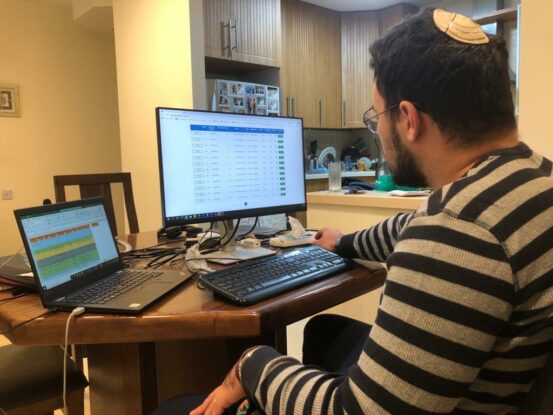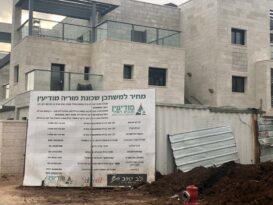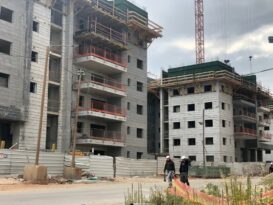Find out everything you need to know about Israel’s latest discounted housing plan, including how to participate, how to increase your chances of winning, where the savings are valued at more than NIS 1.5 million, and whether or not we can expect Israel’s residential real estate to drop. The government lottery for 10,000 affordable housing units began last week.
The Ministry of Housing and Construction has officially kicked off the new “Apartment at a Discount” program (Dira B’Hanacha), a massive housing lottery for 10,000 discounted apartments in 31 cities throughout the country. While the lottery begins today, registration will remain open until March 29. Although the program is primarily meant for first-time home buyers, home-upgraders are also eligible. In this article, we’ll briefly answer six important questions about the program.
1. How do I register for the housing lottery?
In order to participate in the lottery, the first step is submitting an application for a certificate of eligibility. You can either apply online through the website of the Ministry of Housing and Construction or through one of the three registration companies – Alonim, Milgam, or Amidar – each of which has branches throughout the country. If approved, you will receive your certificate of eligibility via email and text message.
The next step is to go to the Ministry of Housing’s lottery site, where you will find a complete list of all of the projects that are open for registration. In the first series of lotteries, each registrant can only sign up for projects in three locations, but in subsequent lotteries, they can sign up for as many projects as they want. After the registration closes, the Ministry of Housing and Construction will hold another lottery for the order in which winning participants will choose their specific apartments. The results of all of the lotteries are sent directly to the winners by email.
2. Where are the discounted housing units located?
Of the 10,000 apartments available through the plan, about 5,000 are located in areas of high demand in the center of the country. The cities with the largest number of housing units in the lottery are Lod (1,420 apartments), Acre (1,035), Ashdod (860), Dimona (733), Ofakim (521), Be’er Ya’akov (512), Jerusalem (462), Tiberias (444 ), and Rishon Lezion (409).
3. Which project is the most profitable?
The Dira b’Hanacha “Apartment at a Discount” housing lottery campaign also incorporates several other affordable housing programs initiated by the government in recent years: the “Buyer’s Price” program (mechir lamishtaken), promoted by former Minister of Finance, Moshe Kahlon, which still has several projects that have not yet been sold off, the “Housing at a Reduced Price” program, drawn up by former Minister of Housing, Ya’akov Litzman, and the “Target Price” program, proposed by the current Minister of Housing, Ze’ev Elkin. Among these projects, the “Buyer’s Price” program offered the most significant discount, so the projects promoted through this program are considered the most profitable.
Of all the projects in the lottery, the “golden ticket” with the most significant discount is called “Maccabi Yafo,” named after the soccer field that used to be on this site. This affordable housing complex is located in the heart of one of the most sought-after areas in the country, south Tel Aviv. There are currently 350 apartments being built as part of this project, 163 of which are in the lottery for discounted housing units, as per the 2018 “Buyer’s Price” tender, won by Acro Real Estate and Ashdar Building Company.
The discounted apartments are selling for NIS 17,400 per square meter, compared to a market price of about NIS 35,000 per square meter. According to these numbers, when linked to the Construction Cost Index, an apartment of 100 square meters is expected to sell for NIS 1.9 million, compared to a market price of at least NIS 3.5 million for a similar apartment in this area. With a net profit and tax exemption of over NIS 1.5 million on a brand new apartment in a high-demand area, this is certainly one of the most profitable projects in the lottery.
The incredible value was certainly not lost on the Israeli public; at the time of writing this article, almost 14,000 people have already registered for the lottery, each with a 1.1% chance of winning. By the time registration closes, the rate of probability is expected to drop below 1%.
4. Where do I have the highest probability of winning?
For every project, the chances of winning are affected by two main variables: the city’s level of attractiveness and the number of housing units in the lottery. Naturally, the cities of the central region are the most sought after, so the chances of winning are much lower. However, in at least one major city, the chances of winning are not bad, due to the unique combination of a large supply of apartments and a problematic image. The mixed city of Lod – infamous for recent social problems and ethnic tensions – is far less attractive to buyers than other cities in the area. At the time of writing this article, only 4,130 people registered for the lottery of 1,420 discounted apartments, giving each registrant a 1 in 3 chance of winning, significantly higher than all the other alternatives in the Center.
In Israel’s Northern District, registrants have the best chances of winning in the mixed coastal city of Acre. As of now, about 1,200 people have signed up for a lottery of 1,035 apartments, giving each one an excellent chance of winning. Meanwhile, the only place that is a sure win is the southern city of Dimona in the Negev, where about 550 people are currently registered for 733 apartments.
5. Can I win in more than one city?
No, whoever wins in a lottery is automatically removed from the other lotteries to which they have registered, so it is not possible to win twice. Further, the order in which the lotteries will take place is determined by the size of the locality, from largest to smallest. Therefore, those who want to win Rishon Lezion as a first priority, for example, should make sure to register only for Rishon Lezion and other smaller localities. If he registers for Haifa and wins, he will be automatically excluded from the lottery in Rishon Lezion.
6. If I win the housing lottery, am I obligated to purchase an apartment?
Winning can be waived at any stage prior to signing the contract, and the right passes to those next in line. Once a winner has waived his right, he is free to purchase a property on the free market.
7. When will the winners actually receive their apartments?
In the majority of cases, the winners will have to wait years to move into their apartments. A survey conducted last week by the economic newspaper, Globes, revealed disturbing findings. In 139 of the 150 projects in the lottery – that’s 96% – the application for a building permit has not yet been submitted. Of the remaining eleven, ten are in the process of having their permit issued, and only one project has actually been granted a building permit. From the time an application is submitted, it takes an average of one year to receive a building permit. According to these numbers, the vast majority of winners will have to wait several long and nerve-wracking years until they get the keys to their new home.
Despite being quite common through the “Buyer’s Price” program, it is highly problematic to hold a lottery for projects that do not yet have building permits. In most cases, winners will have to wait many years for their apartments. In extreme situations, the projects may run into trouble and not materialize at all. While the winners do not sign a purchase contract until the developer officially receives a building permit, this reality still exposes winners to a high level of risk. For example, they may offset a significant portion of their winnings to rent during the waiting years, or they may not be able to back out and buy a property in the private market if they change their mind. However, housing prices will likely continue to rise during the years of waiting, so if the project does not come to fruition, they will be in a worse situation than when they started.
8. Will a lottery of this scope bring down residential real estate prices in the rest of the market?
This lottery alone may not have an effect on the raging market, but if it is merely the first in a series of several lotteries of this size, like the ones that characterized the peak days of the “Buyer’s Price” program, then these programs will definitely impact the market. If this is the case, we can expect to see a halt in the skyrocketing housing prices for at least a year or two.
For large programs, such as “Buyer’s Price” and “Apartment at a Discount,” the main factor that brings down prices is removing first-time apartment buyers from the market, as these buyers make up about 40% of the total buyers. When a large portion leaves the general market to participate in the lotteries, wait for the results, and then winners wait many years for construction, there is a significant decrease in the demand for housing units in the free market. The “Buyer’s Price” program certainly had a short-term cooling effect on the market, and we can expect the same here.
As for a long-term impact, the situation is less clear. Critics of the “Buyer’s Price” program claim that the increase in prices over the past year is a long-term result of the program. Because the demand for apartments was artificially reduced by the government through the affordable housing program, there was a sudden resurgence once it was over, which led to a sharp and sudden rise in prices.







